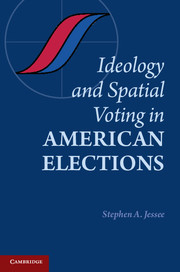Book contents
- Frontmatter
- Contents
- List of Figures
- List of Tables
- Preface
- 1 Introduction
- 2 Political Ideology
- 3 Measuring Political Ideology
- 4 Linking Theory and Empirics: Testing Spatial Voting Theory
- 5 Partisanship versus Proximity: The Effect of Party Identification on Spatial Voting
- 6 Political Information and Spatial Voting
- 7 The Political Perceptions of Citizens
- 8 Conclusion
- Appendix A Survey Question Wordings
- Appendix B Survey Sample Characteristics
- Appendix C Simplified Analyses of Ideology and Spatial Voting
- Appendix D American National Election Studies Analyses
- Bibliography
- Index
Appendix C - Simplified Analyses of Ideology and Spatial Voting
Published online by Cambridge University Press: 05 August 2012
- Frontmatter
- Contents
- List of Figures
- List of Tables
- Preface
- 1 Introduction
- 2 Political Ideology
- 3 Measuring Political Ideology
- 4 Linking Theory and Empirics: Testing Spatial Voting Theory
- 5 Partisanship versus Proximity: The Effect of Party Identification on Spatial Voting
- 6 Political Information and Spatial Voting
- 7 The Political Perceptions of Citizens
- 8 Conclusion
- Appendix A Survey Question Wordings
- Appendix B Survey Sample Characteristics
- Appendix C Simplified Analyses of Ideology and Spatial Voting
- Appendix D American National Election Studies Analyses
- Bibliography
- Index
Summary
In this appendix, simplified models of vote choice are presented based on additive ideology scales, partisanship, and additive political information scales in contrast to the more sophisticated analyses involving latent traits model estimates for ideology and political information. While more sophisticated models confer important advantages, including the ability to obtain meaningful measures of uncertainty and to perform direct statistical tests of specific hypotheses, they also rely on assumptions whose validity can be questioned. Therefore, it is useful to attempt to replicate these analyses using simpler measures. The results presented here demonstrate that the central findings of the book are not driven by the specific statistical models employed, but that the same conclusions also are reached when using more basic measures and models.
This appendix introduces a simpler method of estimating the ideological positions of voters and candidates based on the percentage of surveyed issues on which each respondent or candidate took a conservative position. These liberal-conservative issues are coded based on common understandings of the ideological direction of each proposal. Furthermore, these ideological directions were in agreement with the signs of the discrimination parameters estimated in more sophisticated models (see Tables 3.1 and 3.2) in all but two cases. First, S. Amdt. 3107 to S. 1637, which dealt with altering overtime pay regulations, was coded here as a liberal proposal despite having a positive (albeit very small in magnitude) discrimination parameter estimate.
- Type
- Chapter
- Information
- Ideology and Spatial Voting in American Elections , pp. 204 - 213Publisher: Cambridge University PressPrint publication year: 2012



